|
Synthetic Strings for Tennis Rackets, for the World's Top Pros
Gosen Co., Ltd.
Written by Sakagami Kyoko, Photo by Moritake Takashi
Gosen is sometimes called the company that changed racket sports. That's because of the strings in its rackets. Spurning conventional natural gut, which comes from the intestinal tract of sheep or cows, Gosen began developing synthetic nylon strings in the late 1950s.
The company president, Matsuo Kiyoshi, recalls, "Critics claimed that synthetic string was weaker than natural gut and tended to stretch more. So, we just put more effort into developing a string with optimum 'playability,' durability and tension."
By 1973, Gosen developers had given their synthetic string the same durability as natural gut. In 1999, the company developed an environmentally friendly, biodegradable string made from corn.
Gosen now enjoys 60% of the world market for synthetic racket strings. Anna Kournikova of Russia and other top tennis players swear by Gosen's strings. The high cost of natural gut, and the difficulty in obtaining it, may soon place Gosen's products on top.
|

The company president, Matsuo Kiyoshi, played badminton in his student days, and even placed first in the Asian championships.
|